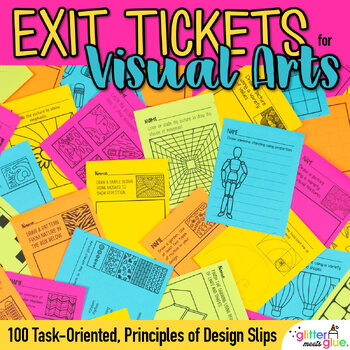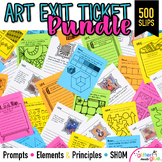Art Exit Tickets Principles of Design Task-Oriented Exit Slips Elementary Middle
- Zip
What educators are saying
Also included in
- Never make another art exit slip again! Take back your nights and weekends struggling to come up with bell ringers and exit tickets for your elementary and middle school art curriculum. No more figuring out the perfect ending to your observation lesson. Imagine having 500 drawing and writing promptsPrice $26.99Original Price $30.00Save $3.01
Description
Teaching a principles of design lesson and need to use art exit tickets as a formative assessment? Polish off your next scheduled observation with this comprehensive pack of 100 unique exit slips for art. They're practically no prep, easy to implement, and a total time saver!
These task-oriented exit tickets are designed for assessing the principles of design in elementary and middle school art class. If your project is about balance, contrast, emphasis, movement, proportion, repetition, rhythm, unity, or variety, these make quick art assessments.
And, you can use the gathered data to inform your SGO/SLO.
TEACHER DIRECTIONS
There are a few ways to implement exit tickets in the art room, whether it be as a bellringer or, at the end of a lesson or unit of study.
For example, you could choose an exit slip and have everyone complete it.
So, if 5th grade is learning movement, pick the exit ticket where students draw a simple object in motion in 5 squares. Similar to drawing a comic strip with panels.
Or, maybe you want 3rd graders to demonstrate they understood rhythm in art. Photocopy the 6 exit tickets that begin with, “Draw an example of ____ (flowing, irregular, regular, random, alternating, and progressive rhythm). Then give each student at a table a different ticket. This way you know they’re drawing original ideas and not looking at their neighbor’s paper.
Similarly, if you’re teaching about the principle of design called unity, there are 4 exit tickets about creating unity in art. But each has a question that’s slightly different.
However, if you’re a fully choice-based art teacher you may choose to print out all 100 art exit tickets and put them in labeled folders according to the principles of design. Then, instruct students to pick one from a certain folder.
Art exit slips are a great way to gauge student learning concepts and assess standards. Each prompt comes 4 to a page. Simply print and go!
YOU WILL RECEIVE
- 9 Non-Editable PDFs (One for Each Principles of Design)
ART EXIT TICKET EXAMPLES
Balance (Symmetry)
- Color all the radially symmetrical shapes.
- Draw a picture in the box below to illustrate informal balance.
Contrast
- Draw a picture in the box below using texture to show contrast.
- Shade the picture to show a strong contrast in value.
Emphasis
- Complete the picture using lines to show emphasis.
- Draw a picture using the rule of thirds to create emphasis. Place your focal point on one of the thirds.
Movement
- Color or shade the picture to show the illusion of movement.
- Complete the picture below using at least two ways to show a sense of movement.
Proportion (Scale)
- Draw an object. Make the focal point line up with the center of the spiral.
- Draw a friendly or fierce monster. Exaggerate one part either too bog or too small.
Repetition (Pattern)
- Finish drawing the quilt pattern. Copy the motifs.
- Draw a pattern from nature in the box below.
Rhythm
- Draw an example of an alternating rhythm in the box below.
- Draw a castle. Use at least two types of rhythm in your design.
Unity (Harmony)
- Draw a picture using similar lines to show a sense of harmony.
- Circle the picture that uses alignment to show unity.
Variety
- Complete the picture using a variety of lines, colors, and shapes.
- Draw a picture of a variety of man-made and natural objects.
YOU MAY ALSO LIKE
- Studio Habits of Mind Posters
- Elements of Art Exit Tickets
- Art Exit Slips: Aligned to the Studio Habits of Mind
Created by Amie Bentley, © Glitter Meets Glue Designs, LLC






